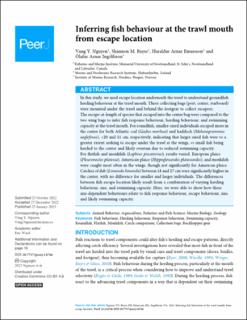| dc.description.abstract | In this study, we used escape location underneath the trawl to understand groundfish herding behaviour at the trawl mouth. Three collecting bags (port, center, starboard) were mounted under the trawl and behind the footgear to collect escapees. The escape-at-length of species that escaped into the center bag were compared to the two wing bags to infer fish response behaviour, herding behaviour, and swimming capacity at the trawl mouth. For roundfish, smaller-sized individuals escaped more in the center for both Atlantic cod (Gadus morhua) and haddock (Melanogrammus aeglefinus), <20 and 11 cm, respectively, indicating that larger-sized fish were to a greater extent seeking to escape under the trawl at the wings, vs small fish being herded to the center and likely overrun due to reduced swimming capacity. For flatfish and monkfish (Lophius piscatorius), results varied. European plaice (Pleuronectes platessa), American plaice (Hippoglossoides platessoides), and monkfish were caught most often in the wings, though not significantly for American plaice. Catches of dab (Limanda limanda) between 18 and 27 cm were significantly higher in the center, with no difference for smaller and larger individuals. The differences between fish escape location likely result from a combination of varying herding behaviour, size, and swimming capacity. Here, we were able to show how these size-dependent behaviours relate to fish response behaviour, escape behaviour, size, and likely swimming capacity. | |
